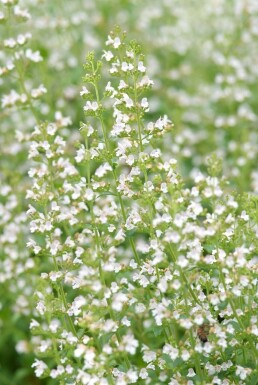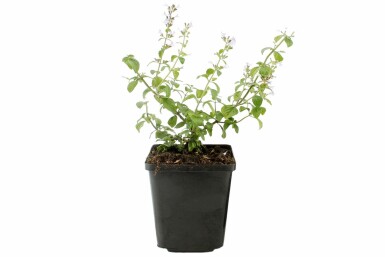Description
Clinopodium nepeta subsp. nepeta | Lesser calamint
Clinopodium nepeta subsp. nepeta, known commonly as lesser calamint, is a delightful herbaceous perennial that brings a touch of wild charm to any garden. With its soft, delicate blooms and pleasing aroma, lesser calamint is a favourite among gardeners looking for a low-maintenance yet visually appealing addition to borders and edges.
Originating from North Africa, Western Asia, and Europe, this plant thrives in sunny locations and is tolerant of a variety of well-drained soils.
Key Features
Clinopodium nepeta subsp. nepeta is celebrated for its bushy, spreading growth habit and its ability to add textural contrast to your garden. Here are some key features to consider:
- Lesser calamint blooms with beautiful, delicate white and purple flowers from June to August, attracting pollinators and adding a splash of color to the garden.
- With a semi-evergreen foliage that remains green from spring through autumn, this plant maintains its visual appeal throughout the growing season.
- It's a fragrant species, which makes it a pleasant addition to spaces where you can enjoy its scent.
- Clinopodium nepeta subsp. nepeta is a drought-resistant plant, making it a suitable choice for gardens in drier climates or for gardeners seeking water-wise plants.
- The ultimate height of this plant is a modest 40 cm, making it an ideal choice for border fronts or edge plantings, where it won't overshadow neighboring plants.
Tips
- For optimal growth, plant Clinopodium nepeta subsp. nepeta in a location that receives full sun.
- Ensure the soil is well-drained; lesser calamint does not tolerate waterlogged roots.
- Water the plants by submerging when needed, especially during the establishment phase or extended dry periods.
- Propagate Clinopodium nepeta subsp. nepeta by sowing seeds or through division to rejuvenate older clumps and encourage healthy growth. Division is best done in the spring or autumn.
- Although it is drought resistant, regular watering during prolonged dry spells will keep the plant looking its best.
- Minimal pruning is required, but deadheading after the main bloom can encourage a second flush of flowers and maintain a tidy appearance.





























